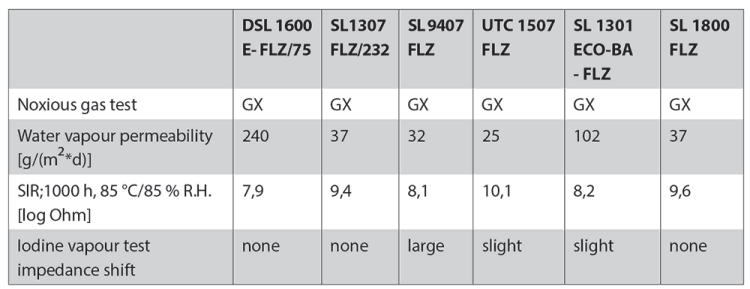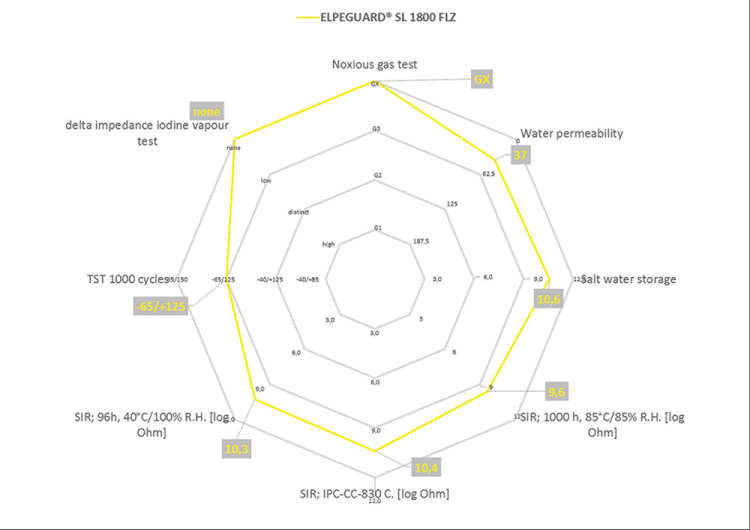
There are various characteristics which can impair the operational reliability of an electronic assembly. One major characteristic responsible for the failure of an electronic assembly is the effect of moisture, for example, due to humidity from the air. As a classical means of protecting against failure through moisture, conformal coatings are applied, which are exposed to moisture on a more-or-less regular basis.
Again and again, this circumstance gives rise to the question from users of whether it is possible to test such conformal coatings as to their performance. From the customer’s perspective, a clearly measurable characteristic permitting them to draw conclusions about the quality of a conformal coating would be an ideal solution.
Quite often, the customer is keenly interested in knowing or measuring the water vapour permeability or water absorption in order to evaluate the suitability or non-suitability of a conformal coating in terms of protecting the electronics against moisture. Besides an evaluation of water absorption and water vapour permeability, a variety of test methods – such as noxious gas tests or iodine vapour tests – are commonly performed to describe the functionality of a conformal coating in terms of moisture.
The studies presented in this article are focused on a comparison between the water vapour permeability test and other tests, as well as on the correlation of the results. Conversely, one would also assume that the measuring of a value permits a definitive evaluation of the conformal coating’s functionality.
Coating materials differ both in terms of water absorption and water vapour permeability, which may have an effect on mechanical properties, adhesion, glass transition temperature, light and weathering resistance, corrosion protection properties and electrical insulation properties.
Moisture and water are among the most harmful factors affecting coating materials. Actually, the water vapour permeability and moisture absorption of polymers, i.e., coating layers, are not absolute criteria determining their exclusion as insulating materials. To a certain extent, all polymers are permeable to water vapour; this characteristic is called permeation. By the same token, all polymers soak up moisture, which is referred to as absorption.
Both characteristics – water absorption and water vapour permeability – can be measured by appropriate methods. In the case of water absorption, the result is expressed as a percentage, while for water permeability, the result is indicated as a value of mass per surface area and layer thickness.
Neither of these two values is an absolute characteristic; they depend on temperature, the prevailing relative humidity (actually on the partial water vapour pressure) or the presence of condensed water on the coating film. The correlation is shown in Figure 1 – without considering, however, the influence of any given contamination.
By knowing these characteristic values, one possesses information on the water balance of a coating material. However, this does not include any details related to the effects of the water balance on electrical insulation properties, meaning the movement of electric charge carriers in the polymer film. Moreover, the values of water vapour permeability and water absorption cannot be regarded as independent of one another. With increasing water absorption, the water vapour diffusion may rise significantly.
By way of example, the water vapour permeation for various Peters ELPEGUARD conformal coatings is shown in Table 1. The characteristic describing this insulation behaviour is the so-called moisture/insulation resistance value (MIR) which is often used as a synonym for SIR (surface insulation resistance). Further below, the electrical insulation resistance under moisture is looked at in detail.

The moisture/insulation resistance used in many different qualification procedures is a combined property of both the material and the electrode system. It displays a complex resistance system between two metal electrodes in a comb pattern composed of different dielectrics such as laminate, coating, air and air humidity, as well as possible leakage currents from ionic contamination, i.e., the movement of charge carriers in this electrode system.
The above property describes the direct electrical impacts of moisture absorption in this electrode system, which are similar to those found on an electronic circuit carrier. An insulation drop induced by moisture absorption is described as a remaining insulation value.
A general characteristic of the operational reliability of electronic assemblies is the so-called surface resistance; falling below 1 MΩ is generally considered to be critical. In the case of a conformal coating, the previously given surface resistance (SIR) between the potentials is replaced by the electrical resistance of the coating film. For this reason, the electrical resistance is often described as the SIR value, which is not strictly correct. In various rules and standards, for example, the acceptable drop in insulation under moisture (temperature) load is limited to 100 MΩ.
The comb patterns found on various IPC test boards are typical test structures for measuring the moisture/insulation resistance. By way of describing conformal coatings, test boards of the types IPC-B24 and IPC-B25A are primarily used.
Such a test is employed to instantly detect moisture-induced failures. Similar to the so-called ‘highly accelerated stress test’ (HAST), it includes different temperature levels and/or different air humidity levels.
Among typical temperature/moisture combinations, one would find, for example, 65°C/90% RH (relative humidity) or 85°C/85% RH. The moisture covers the surface of the measuring arrangement or it is absorbed by the polymers and the applied bias (usually between 5 and 100 V DC) generates an electrolytic cell. Among the typical failure mechanisms, there are electrochemical corrosion processes and/or delaminations.
These tests can be performed:
• As part of a product qualification (solder resist, conformal coating, no-clean flux, etc.).
• As part of a process qualification (conformal coating, solder processes, cleaning processes, etc.).
• For comparing different materials.
• For comparing different processes.
In this context, the moisture and insulation resistance can be regarded as a composite parameter, as a qualifying feature describing the results of different physical characteristics by reducing them to one single characterising feature.
Typical dependencies of the moisture/temperature behaviour of conformal coatings (Figure 2a) and their descriptions vis-à-vis moisture/insulation resistance are depicted in the Tomlins curves of Figure 2b. These diagrams also display the typical transient effects of the resistance value, for example, in the drying phase (Figure 2b). These transient curves are typical diffusion-related dependencies. A typical transient of moisture absorption can be taken from the detailed section of a gradient (Figure 3).
Figure 3 displays the transient effects of the moisture/insulation resistance for a coating film measured in the initial phase of a condensation water test at 40°C, 100% RH and 100 V. This diagram covers several conformal coating films (differently coloured lines) and also includes the error function (erf(x), represented by the dashed blue line) which describes the typical mathematical solution of the unidimensional diffusion equation. This means that the transient effects can be described mathematically through a diffusion process, or to put it another way, diffusion processes underlying water vapour permeability can be determined through a drop in moisture/insulation resistance. Here the usual detectable diffusion values have been obtained as electrical resistance values. The same applies to water absorption values, usually given in percentages, which can be obtained as electrical resistance values directly through moisture/insulation resistance.
Table 2 shows the results of various tests conducted with six ELPEGUARD conformal coatings. It should be noted that these do not allow one to draw a correlation based on the results indicated.

Figure 4 displays various test results related to the acrylate-based conformal coating ELPEGUARD SL 1800 FLZ which allow the establishment of a correlation through direct comparison. This approach clearly shows that water absorption and water vapour permeability are important characteristics for looking at the protective effect, although every value alone is not significant enough to allow a general statement on the quality of a conformal coating in terms of resistance against environmental loads and above all, against moisture loads.

Measurements of moisture and insulation resistances (so-called SIR or MSIR (moisture SIR) values) can be measured and directly utilised as electrical resistance values. If such electrical resistance values are determined in sequential test series (measuring SIR values under condensation test K08, temperature cycle test K05, noxious gas test K18, etc.) in the context of validation studies, the addition of these values must easily allow evaluation of the quality of the conformal coating applied. Performed on assembled validation boards, this not only permits the evaluation of the material employed, but also the qualification of the complete conformal coating process and the upstream soldering process of the electronics.
| Tel: | +27 11 824 1427 |
| Email: | [email protected] |
| www: | www.techmet.co.za |
| Articles: | More information and articles about Techmet |

© Technews Publishing (Pty) Ltd | All Rights Reserved